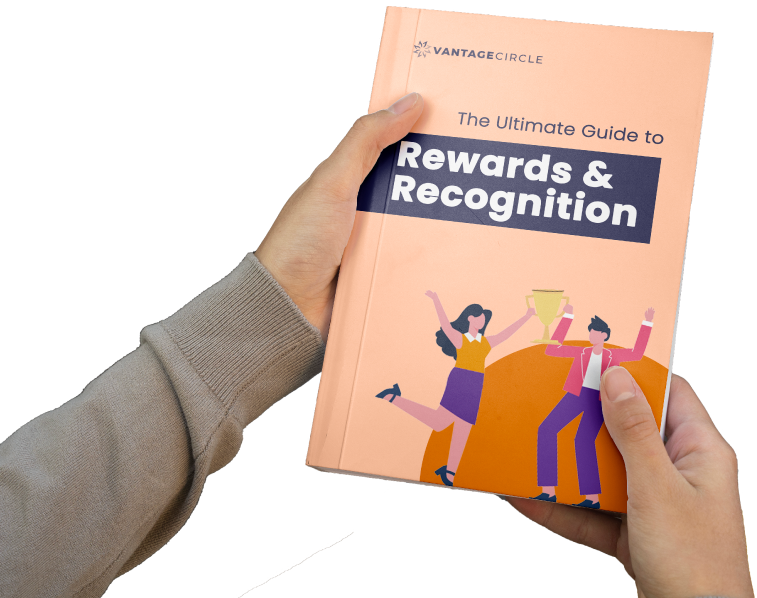27 Employee Rewards Examples Boosting Motivation and Engagement

A Global Employee Recognition and Wellness Platform
Everyone likes to feel seen and appreciated at work. It’s a fact you can’t deny.
In fact, when it comes to acknowledging someone even a simple “thank you” can go a long way. But you know what, the right reward can stick with someone for longer. And it can have a lasting impact.
There’s a catch though. Simply rewarding is not good enough. You’ve to recognize efforts in a way that feels genuine and personal.
You may be wondering why “personal.” Because what feels rewarding to one person might not mean much to someone else. One of your team members may appreciate public recognition, but one other may prefer a quiet gesture, like an extra day off or a handwritten note.
And the same goes for the “context.”
A reward that works after someone finishes a big project might not feel right for a fifth anniversary. In simple words, different moments call for different kinds of recognition.
In this blog, we’ll walk you through some real, effective employee reward examples. One that makes people feel valued, not just acknowledged. Let’s get into it.
Examples of Employee Rewards- Monetary vs Non-monetary
“Employee rewards,” I bet whenever you hear this term, your mind probably jumps to bonuses or gift cards first. But much to your surprise, rewards don’t always have to be tied to a budget. Yes, financial rewards matter but non-monetary rewards are no less.
In fact, according to a SHRM study,
Non- cash rewards can improve productivity by as much as 44% in some organizations.
So, let’s start with the non-financial rewards that can quietly make a big difference.
A. Non- Financial Employee Rewards
1. Recognition Program

You don’t need a big budget to make someone feel valued. Sometimes all it takes is a simple shout-out during your team meeting. Even better, a heartfelt message in the group chat.
At the end of the day, it’s about highlighting and appreciating your team members’ great work. No matter if it’s finishing a tough call with grace or stepping up to help a teammate. Consistent efforts build a culture where people feel seen.
Over time, that kind of consistent, everyday recognition becomes part of how your team shows up for each other.
Do Give a Read: Employee Recognition Guide: Strategies for Motivating and Engaging Your Team
2. Career Development Opportunities
Growth can be its own kind of reward.
You’ve read it right. Offering your team members a chance to take on new challenges or learn something beyond their usual role can be incredibly motivating.
For instance, maybe someone on your support team wants to explore marketing. So, why not loop them into a content brainstorm? Or maybe a junior employee shows leadership potential. You can consider involving them in mentoring a new hire.
There might be plenty of such cases. But you’ve got to be aware, approachable and forward-thinking to spot those opportunities.
You can also take a cue from Salesforce. The Salesforce totally gets that growth is its own kind of reward. They’ve built this cool platform called Trailhead where employees can pick up new skills. In fact, they recognize and reward those who take learning seriously. It’s like saying, “You grow, we grow. Let’s do it together.”
3. Work-Life Balance Initiatives

Work hard, party harder. If your employee gets to live like this, you’re golden.
Yes, helping your team create healthy boundaries shows that you respect their time, not just their output. Maybe, it’s enforcing “no-meeting Fridays,” or encouraging them to use their time off, without guilt.
You know what, even simple things like flexible hours or remote Fridays can make a big difference. It’s about trusting your people to get things done their way. And not the old-school 9-to-5 way.
4. Wellness Programs

Source: Vantage Fit
From stress to screen fatigue, today’s work can take a toll. That’s where thoughtful wellness programs step in. A guided meditation session, mental health day, or even an on-site yoga class. It all adds up.
And you know what, you don’t need a fancy app to show that you care. Sometimes, just normalizing, “It’s okay to take a break” can go a long way.
If you're looking to support mindfulness in a simple way, even something like Vantage Fit’s in-app guided meditations can help your team pause and reset. Right from their phones.
5. Monetary Employee Rewards
Sometimes, a thank-you is best delivered with numbers.
Yes, monetary incentives show employees that their contributions have a measurable impact. And that the business is willing to invest in their performance.
From bonuses to profit-sharing, here are a few ways companies can offer meaningful financial recognition:
6. Bonuses and Commissions
Everyone appreciates a little extra when they go above and beyond. It’s a fact that we better not deny it.
After all, bonuses and commissions are the most direct way to tie performance to reward. Financial incentives reinforce the behavior you want to see more of. No matter if it’s hitting quarterly targets, closing a tough deal, or simply putting in consistent effort.
For Instance,
Netflix has this interesting approach called the “Keeper Test.” Managers regularly ask themselves, “Would I fight to keep this person if they told me they were leaving?” If the answer is yes, that employee isn’t just recognized. They’re rewarded with top-tier compensation and growth opportunities. It’s Netflix’s way of saying, “We see your value, and we want you here for the long haul.”
7. Gift Cards and Vouchers

Source:Vantage Perks
Quick, flexible, and always a big hit.
Gift cards and vouchers might seem small, but they pack a punch when it comes to recognition. You can use them to celebrate your team’s small but meaningful wins.
And the best part? They give your team members the freedom to choose something they genuinely enjoy.
8. Pay Raises
When someone keeps showing up and stepping up, a raise says it loud and clear.
And trust me, a raise is more than just extra money. It’s a depiction of trust. It clearly shows you’re in it for the long haul.
You see their growth. And you’re ready to grow with them.
9. Profit Sharing
Let your team members share the success they have helped create.
Profit-sharing programs turn employees into stakeholders. When your team knows that a portion of the company’s success is shared with them, it deepens their connection to the bigger picture. It, in fact, fosters a sense of ownership, collaboration, and a shared goal.
B. Employee Rewards for Remote and Hybrid Workers
Out of sight shouldn’t be out of recognition.
As teams go remote or hybrid, traditional reward systems need refreshments. And you know, your employees working from home face different challenges.
-
Blurring work-life lines
-
Social isolation
-
Tech fatigue
Thoughtful rewards can help bridge that distance and make people feel valued.
10. Home Office Upgrade Allowance

Working from a kitchen table or couch isn’t sustainable.
An allowance like this gives your team members the freedom to invest in better chairs, desks, or monitors. It helps them feel more equipped, comfortable, and productive in their space.
11. Internet/Utility Bill Subsidies
Covering part of their internet or electricity bills shows you recognize the hidden costs of working from home.
12. Digital Gift Cards for Food Delivery
These gift cards are more than convenient. They’re a reminder to pause, enjoy a good meal, and feel cared for even without a shared office kitchen.
13. Virtual Experience Vouchers

I am sure you understand the downside of remote work. Working from home can get lonely and repetitive for your employees. So, offering them something like vouchers for virtual shows, classes, or experiences adds novelty to their week. Also, it gives them something new to talk about, share, and enjoy.
14. Flexible “No Meeting” Days
When every day feels like a back-to-back video call, mental fatigue kicks in. A day without meetings is a small shift that can create massive relief. Needless to say, it’ll offer your employees time to breathe, think and focus deeply without disruption.
15. Remote Wellness Packages
You can send curated kits with herbal teas, snacks, journals, or mindfulness tools to your employees. It’ll make wellness feel personal and accessible, no matter where someone works from.
16. Remote Recognition Platforms
Praise doesn’t have to wait for performance reviews or team calls.
There are platforms that’ll help you recognize and appreciate your employees in real time. No matter the distance.
One such platform is Vantage Circle, which makes it easy to celebrate wins, give shoutouts, and keep recognition flowing. That too, across time zones and team chats.
17. Surprise Home Deliveries

Remote workers miss spontaneous moments like birthday cakes or desk drops.
A surprise package at their doorstep, tailored to their interests, brings back that human touch and makes recognition feel real and memorable.
C. Social Rewards for Employees
You know what, not all recognition needs to come in the form of a bonus or a gift card. Sometimes, the most powerful rewards are the ones that spark connection, belonging, and shared celebration.
In fact, social rewards bring a layer of fun, personality, and peer appreciation into the mix. And in the process, it makes recognition feel more human.
Do Give a Read: Social Recognition Basics: A Quick Guide
18. Digital “Wall of Fame” with Employee Stories

Source: Vantage Recognition
You must go beyond just names. Feature real stories, photos, or even short videos that highlight employee wins in a more personal and lasting way.
19. Peer-Nominated “Culture Champion” Badges
Let your team decide who truly lives the company values. These digital badges live on internal profiles and are a fun, visible nod to what makes your culture strong.
20. Recognition Reaction GIF Parties
How about celebrating a win with nothing but GIFs.
You can host a quick virtual party where team members react to a colleague’s achievement. No words, just creativity and good vibes.
21. Crowdsourced Playlist Dedications
Got a music-loving team?
In that case, you can let your peers build and dedicate Spotify playlists that capture someone’s energy or contribution. It's personal, thoughtful, and always fun.
22. Virtual Applause Rooms
Hop into a quick video call where everyone just claps, cheers, or gives a shoutout. It’s spontaneous, sincere, and often the highlight of someone’s day.
23. Social Media Takeover Days
Let your team members run the show for a day.
You can hand over the company’s Instagram or LinkedIn for a day. Recognized employees can share their journey, passions, or a sneak peek into their work life.
It’s going to be fun, and you will get some amazing content.
24. Recognition Chain Emails
You can also start a thread of gratitude. One employee recognizes another, who then keeps the chain going. It’s peer-to-peer appreciation that scales naturally.
25. Digital Trophy Pass-Along
Think of it like a traveling award. A digital trophy gets passed along with a short thank-you or a note of wisdom.
26. Team Gratitude Walls
Sometimes, a simple “thank you” goes a long way. I am sure you must have read this several times by now.
You can create a shared space (think, virtual whiteboard or slack channel) where teammates can drop quick shoutouts, doodles, or kind notes. It’s low-effort, high impact, and slowly builds a culture where appreciation is part of the everyday rhythm.
27. Employee-Hosted Virtual Masterclasses

Have you got a designer who bakes or a coder who paints? Hand them the mic.
These fun, casual sessions let your team share their hidden talents and connect over something other than deadlines and dashboards.
Final Thoughts
At the end of the day, rewards aren’t just about perks, they’re about people.
They’re about noticing the quiet contributors, the behind-the-scenes heroes, the ones who show up even when no one is looking. They’re about building a culture where appreciation isn’t a scheduled activity, but something that lives and breathes every day.
And as you’ve seen, meaningful recognition doesn’t always need a big budget. It just needs intention. A little creativity. And a willingness to ask: What would make this person feel truly valued?
So, here’s a question for you.
When was the last time your team felt genuinely recognized?


















